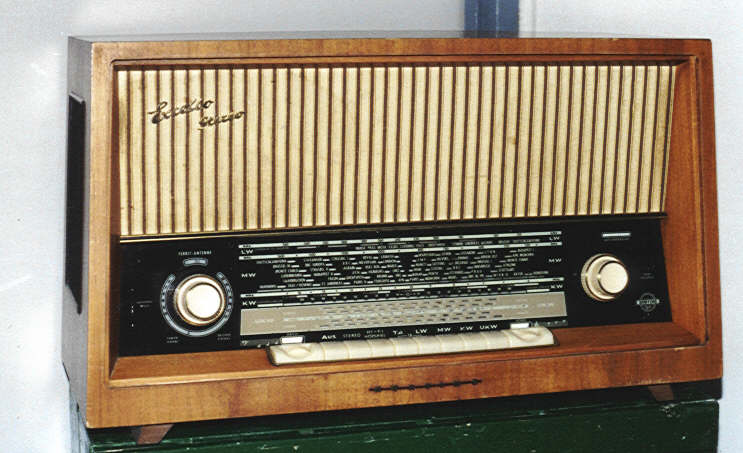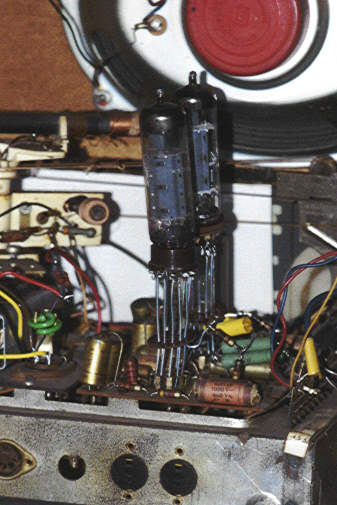
136
Item nr.

Korting Excello Stereo 23621 Table top
Stereo radio, found new home in Paris.
Data for Korting Excello Stereo 23621
| Production | West Germany, 1963.
|
|---|
| Bands | LW (150-360kHz), MW, SW (6-18 MHz), FM (88-104 MHz). |
|---|
| Tubes | ECC85 ECH81 EBF89 ECL86 ECL86 EZ80 EM84. |
|---|
Semi-
conductors | Diodes for ratiodetector.. |
|---|
| Cabinet | Wood.
Size 60x34x25 cm.
|
|---|
| Power | AC (110-240V) 70W. |
|---|
The Design
Korting was among the cheaper German brands after about 1956. Before that (from the thirties actually) Koerting was among the more expensive brands, producing high quality sets, including the 1937 Transmare with 15 tubes. Unfortunately, the company got into financial troubles in 1956 and felt forced to sign a contract with Neckermann. This was a major mail-order company. The brand name vanished in Germany, and was used only for export. When Neckermann in its turn was taken over by Karstadt/Quelle (1977), the contacts with Koerting were not continued, and Koerting was liquidated in 1983.The Korting radio depicted here was stereo prepared. This means that it is fitted with two output amplifiers (both implemented by a single ECL86) and for the FM it has IF stages that are wide-banded enough to carry FM stereo signals. However, there is no stereo demultiplexer built in. This could be had later as an additional option, but I have never seen any stereo-prepared radio that actually had the demuxer. I built-in a Philips demuxer from a scrapped stereo set, but this does not seem to work well.
 Tube radios were still quite popular for home use in the early sixties, but a lot of them already came with some semiconductors sneaked in, like selenium rectifiers or germanium diode for detection. A bit later came the transistorized FM tuners like in this Aristona, a few years later the tube are came to an end. The inside picture shows the FM tuner (left side), the ferrite rod that can be rotated by a knob on the front, the stereo demultiplexer that I fitted, and the output tubes on their elevated sockets. The small speaker left is a replacement.
Tube radios were still quite popular for home use in the early sixties, but a lot of them already came with some semiconductors sneaked in, like selenium rectifiers or germanium diode for detection. A bit later came the transistorized FM tuners like in this Aristona, a few years later the tube are came to an end. The inside picture shows the FM tuner (left side), the ferrite rod that can be rotated by a knob on the front, the stereo demultiplexer that I fitted, and the output tubes on their elevated sockets. The small speaker left is a replacement.
| Obtained | 9/1999
from Rommelmarkt Rode Kruis. |
|---|
| Condition | 8. |
|---|
| Disposed | Sold 11/2000. |
|---|
This Object
Many of my radios with ECL86 tubes share a common problem: conduction of small electrical currents through the circuit board, leading to positive voltage on the grid of the output pentode. In the early sixties, printed circuit boards started to replace the discrete style of wiring we know from the fifties and before. The first PCBs were made of pertinax, a kind of pressed paper actually. The heat coming from an output tube causes this stuff to burn a little bit, which forms carbon and this conducts: a resistance of several MegaOhms may thus exist between various strips on the board. The ECL86 has the output section's control grid at pin 8, between the catode (pin 7) and the anode of the triode (pin 9). The impedance of the grid circuit is extremely high (it is usually grounded through a 1 Meg resistor) and this makes the voltage rise easily even with very small print currents. The symptoms are always the same: after about 5 minutes of playing the sound starts to be distorted. What can be done? Most of the sets are simply scrapped, but this one I wanted to keep. I made tube sockets that stand out above the print and made the connection to pin 8 floating above the print.
on the grid of the output pentode. In the early sixties, printed circuit boards started to replace the discrete style of wiring we know from the fifties and before. The first PCBs were made of pertinax, a kind of pressed paper actually. The heat coming from an output tube causes this stuff to burn a little bit, which forms carbon and this conducts: a resistance of several MegaOhms may thus exist between various strips on the board. The ECL86 has the output section's control grid at pin 8, between the catode (pin 7) and the anode of the triode (pin 9). The impedance of the grid circuit is extremely high (it is usually grounded through a 1 Meg resistor) and this makes the voltage rise easily even with very small print currents. The symptoms are always the same: after about 5 minutes of playing the sound starts to be distorted. What can be done? Most of the sets are simply scrapped, but this one I wanted to keep. I made tube sockets that stand out above the print and made the connection to pin 8 floating above the print.
Part of Gerard's Radio Corner.
Generated by SiteBuilder on
26/2/2024
by Gerard
(g.tel@uu.nl)
 Tube radios were still quite popular for home use in the early sixties, but a lot of them already came with some semiconductors sneaked in, like selenium rectifiers or germanium diode for detection. A bit later came the transistorized FM tuners like in this Aristona, a few years later the tube are came to an end. The inside picture shows the FM tuner (left side), the ferrite rod that can be rotated by a knob on the front, the stereo demultiplexer that I fitted, and the output tubes on their elevated sockets. The small speaker left is a replacement.
Tube radios were still quite popular for home use in the early sixties, but a lot of them already came with some semiconductors sneaked in, like selenium rectifiers or germanium diode for detection. A bit later came the transistorized FM tuners like in this Aristona, a few years later the tube are came to an end. The inside picture shows the FM tuner (left side), the ferrite rod that can be rotated by a knob on the front, the stereo demultiplexer that I fitted, and the output tubes on their elevated sockets. The small speaker left is a replacement.


 on the grid of the output pentode. In the early sixties, printed circuit boards started to replace the discrete style of wiring we know from the fifties and before. The first PCBs were made of pertinax, a kind of pressed paper actually. The heat coming from an output tube causes this stuff to burn a little bit, which forms carbon and this conducts: a resistance of several MegaOhms may thus exist between various strips on the board. The ECL86 has the output section's control grid at pin 8, between the catode (pin 7) and the anode of the triode (pin 9). The impedance of the grid circuit is extremely high (it is usually grounded through a 1 Meg resistor) and this makes the voltage rise easily even with very small print currents. The symptoms are always the same: after about 5 minutes of playing the sound starts to be distorted. What can be done? Most of the sets are simply scrapped, but this one I wanted to keep. I made tube sockets that stand out above the print and made the connection to pin 8 floating above the print.
on the grid of the output pentode. In the early sixties, printed circuit boards started to replace the discrete style of wiring we know from the fifties and before. The first PCBs were made of pertinax, a kind of pressed paper actually. The heat coming from an output tube causes this stuff to burn a little bit, which forms carbon and this conducts: a resistance of several MegaOhms may thus exist between various strips on the board. The ECL86 has the output section's control grid at pin 8, between the catode (pin 7) and the anode of the triode (pin 9). The impedance of the grid circuit is extremely high (it is usually grounded through a 1 Meg resistor) and this makes the voltage rise easily even with very small print currents. The symptoms are always the same: after about 5 minutes of playing the sound starts to be distorted. What can be done? Most of the sets are simply scrapped, but this one I wanted to keep. I made tube sockets that stand out above the print and made the connection to pin 8 floating above the print.